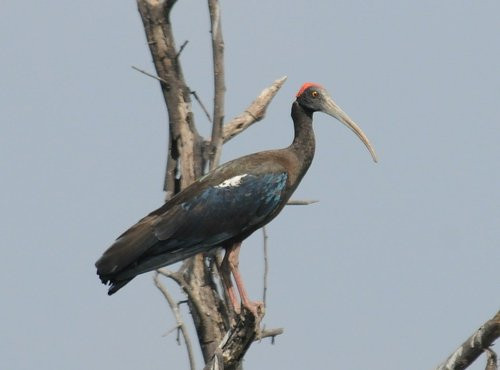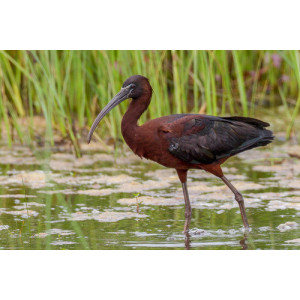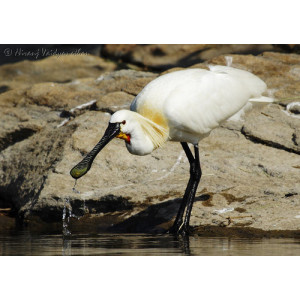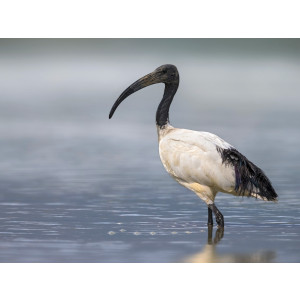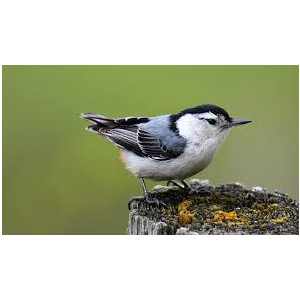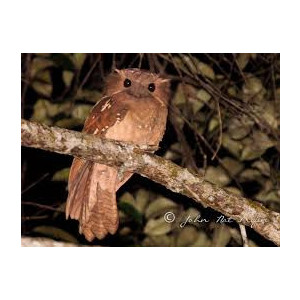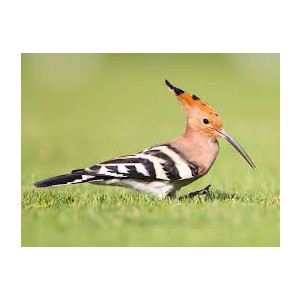Red‑naped (Black) Ibis Did you see this animal?
Scientific Name : Pseudibis papillosa
Family : Threskiornithidae
Order : Pelecaniformes
Class : Aves
Phylum : Chordata
Other Name : Black Ibis
Habitat : Wetlands
Description : The red-naped ibis is a large black bird with long legs and a downcurved bill. Its wing feathers and tail have a black color with blue-green gloss, while the neck and body are brown without gloss. It has a distinctive white patch on the shoulders and a bright red warty patch of skin on the featherless head, known as a caruncle. The iris of the red-naped ibis is orange-red. Both males and females look the same, and young birds have a browner plumage and lack the bare head and crown. During the breeding season, their bills and legs turn reddish.
Red-naped ibises are typically quiet but make calls at dawn, dusk, and more frequently during nesting. Their calls consist of a series of loud braying, squealing screams that decrease in loudness.
Although they can be mistaken for glossy ibises at a distance, red-naped ibises can be differentiated by their larger size, solitary nature, and the presence of white on the wing. Unlike glossy ibises, red-naped ibises are not associated with wetlands, and they have a fully feathered head.
In summary, the red-naped ibis is a large black bird with distinctive features such as the white shoulder patch, red warty patch on the head, and downcurved bill. They make loud calls and can be distinguished from glossy ibises by their larger size, solitary behavior, and feathered head.
The red-naped ibis is an omnivorous bird that feeds on carrion, insects, frogs, small vertebrates, grains, and even crops. They forage in dry open lands, probe the ground for food, and occasionally feed at garbage dumps. During droughts, they adjust their diet to include carrion and insect larvae.
red-naped ibises generally nest individually, but occasionally form small colonies. They construct large stick platforms as nests, often reusing old nests or those of other birds. The nests are located on trees, close to human habitation or even on powerline pylons. The breeding season typically occurs between March and October, and both male and female ibises are involved in incubating the eggs, which hatch after 33 days.
Red-naped ibises are typically quiet but make calls at dawn, dusk, and more frequently during nesting. Their calls consist of a series of loud braying, squealing screams that decrease in loudness.
Although they can be mistaken for glossy ibises at a distance, red-naped ibises can be differentiated by their larger size, solitary nature, and the presence of white on the wing. Unlike glossy ibises, red-naped ibises are not associated with wetlands, and they have a fully feathered head.
In summary, the red-naped ibis is a large black bird with distinctive features such as the white shoulder patch, red warty patch on the head, and downcurved bill. They make loud calls and can be distinguished from glossy ibises by their larger size, solitary behavior, and feathered head.
The red-naped ibis is an omnivorous bird that feeds on carrion, insects, frogs, small vertebrates, grains, and even crops. They forage in dry open lands, probe the ground for food, and occasionally feed at garbage dumps. During droughts, they adjust their diet to include carrion and insect larvae.
red-naped ibises generally nest individually, but occasionally form small colonies. They construct large stick platforms as nests, often reusing old nests or those of other birds. The nests are located on trees, close to human habitation or even on powerline pylons. The breeding season typically occurs between March and October, and both male and female ibises are involved in incubating the eggs, which hatch after 33 days.
Distribution in Bangladesh
References:
description written by:Fatema-Tuz-Zohora,Department of Zoology, Jagannath University,Dhaka;information source: Encyclopedia of Flora and Fauna of Bangladesh, Vol-26, iucnredlist.org;Photo credit and copyright:Syed Abbas (Birdwing,Bangladesh);taxonomic checklist:P. M. Thompson and S. U. Chowdhury (2020). A checklist of birds of Bangladesh.Birds Bangladesh;bird song owner:Frank Lambert(www.xeno-canto.org/Frank Lambert), bird sound copyright reserved according to www.xeno-canto.org rules; more information, please contact us.
description written by:Fatema-Tuz-Zohora,Department of Zoology, Jagannath University,Dhaka;information source: Encyclopedia of Flora and Fauna of Bangladesh, Vol-26, iucnredlist.org;Photo credit and copyright:Syed Abbas (Birdwing,Bangladesh);taxonomic checklist:P. M. Thompson and S. U. Chowdhury (2020). A checklist of birds of Bangladesh.Birds Bangladesh;bird song owner:Frank Lambert(www.xeno-canto.org/Frank Lambert), bird sound copyright reserved according to www.xeno-canto.org rules; more information, please contact us.
